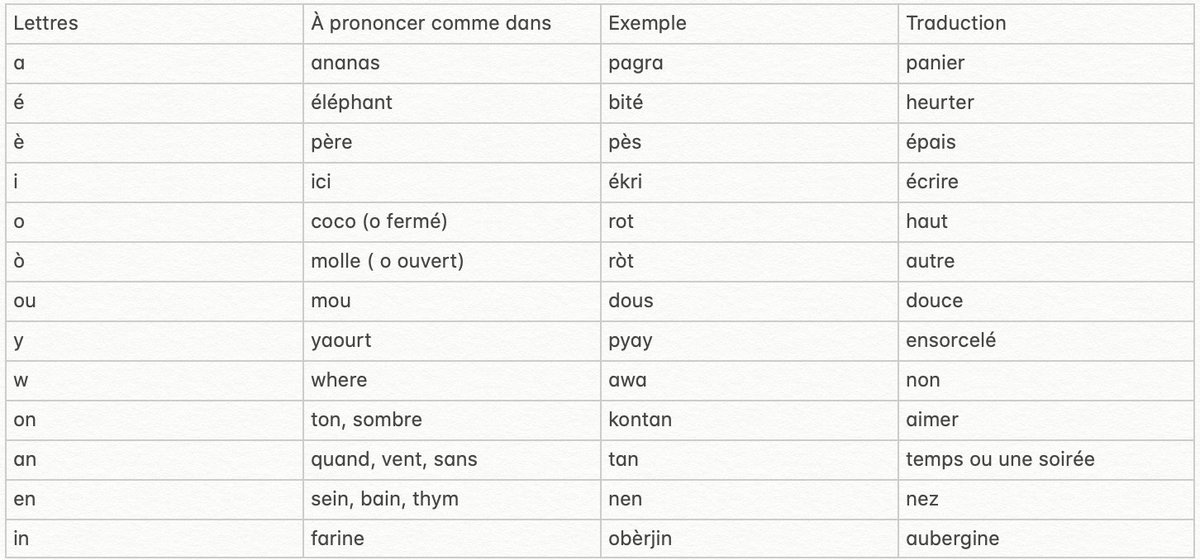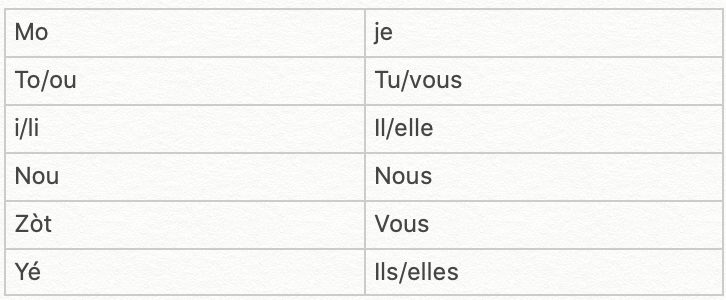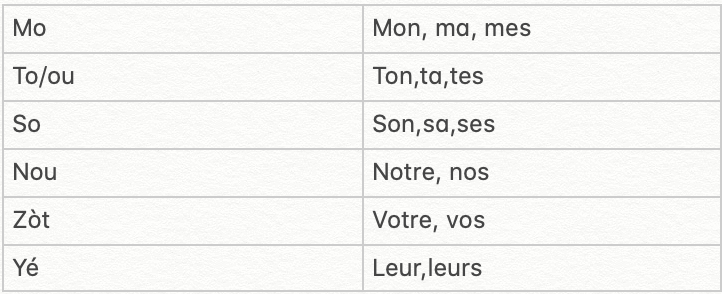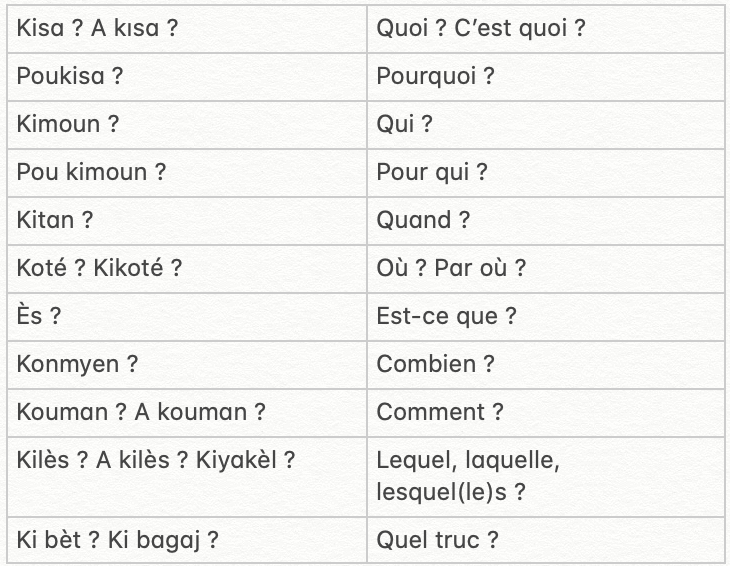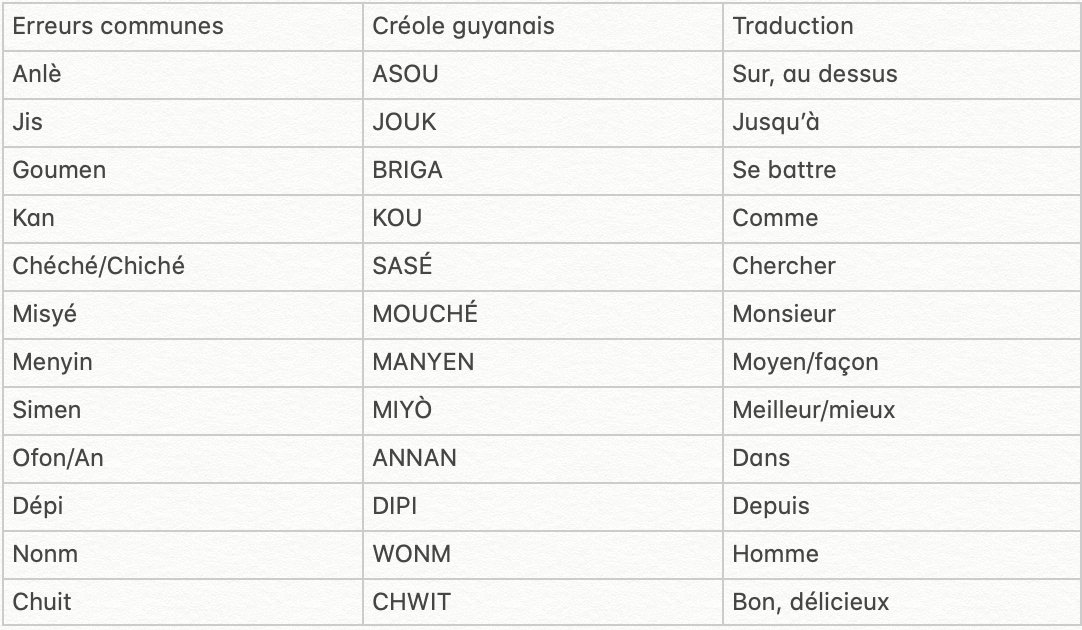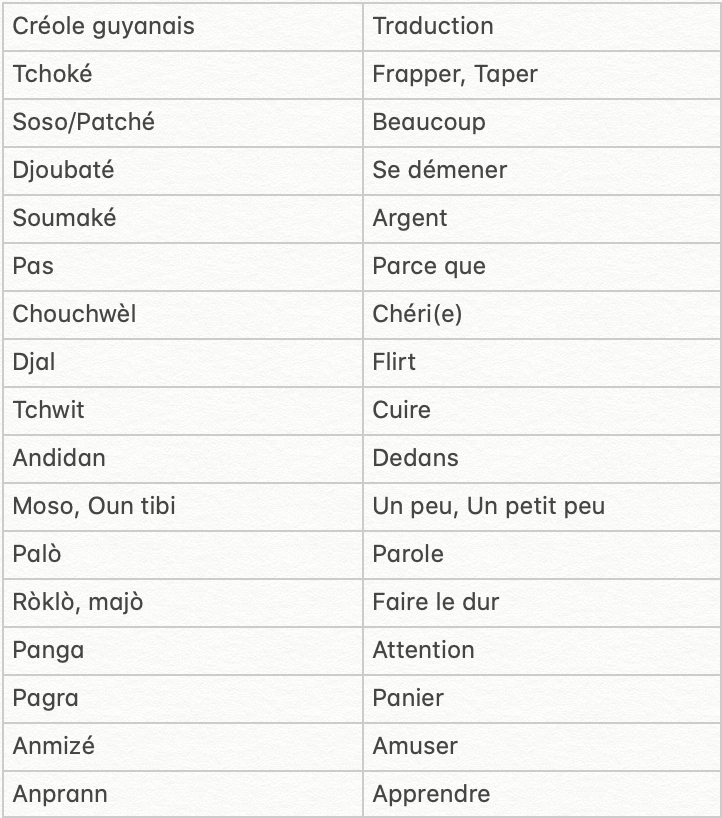Orthographe, grammaire, prononciation, conjugaison et vocabulaire...
On abordera plusieurs aspect du créole guyanais parlé et écrit.
Commencez à ajouter ce thread à vos signets !
On y va !
Il est important de savoir que le créole guyanais s& #39;est construit à travers plusieurs époques. Il n& #39;avait pas encore d& #39;orthographe défini il y& #39;a peu.
Il n& #39;est pas tiré que du français, c& #39;est pour ça que certains mots sont phonétiquement transparents et d& #39;autres non.
Il n& #39;est pas tiré que du français, c& #39;est pour ça que certains mots sont phonétiquement transparents et d& #39;autres non.
Pour commencer, toutes les lettres écrites en créole guyanais ont leur propre son. Il n’y a aucune lettre muette.
À noter que les lettres "h", "q" et "x" n’existent pas.
"c", "k" et "qu" s’écrivent "k".
Exemple : quand https://abs.twimg.com/emoji/v2/... draggable="false" alt="➡️" title="Rightwards arrow" aria-label="Emoji: Rightwards arrow">kitan; casser
https://abs.twimg.com/emoji/v2/... draggable="false" alt="➡️" title="Rightwards arrow" aria-label="Emoji: Rightwards arrow">kitan; casser https://abs.twimg.com/emoji/v2/... draggable="false" alt="➡️" title="Rightwards arrow" aria-label="Emoji: Rightwards arrow">kasé
https://abs.twimg.com/emoji/v2/... draggable="false" alt="➡️" title="Rightwards arrow" aria-label="Emoji: Rightwards arrow">kasé
Exemple : quand
L’écriture du "x" dépendra du mot en question.
Exemple : taxi https://abs.twimg.com/emoji/v2/... draggable="false" alt="➡️" title="Rightwards arrow" aria-label="Emoji: Rightwards arrow">taksi ; exemple
https://abs.twimg.com/emoji/v2/... draggable="false" alt="➡️" title="Rightwards arrow" aria-label="Emoji: Rightwards arrow">taksi ; exemple https://abs.twimg.com/emoji/v2/... draggable="false" alt="➡️" title="Rightwards arrow" aria-label="Emoji: Rightwards arrow">ègzanp
https://abs.twimg.com/emoji/v2/... draggable="false" alt="➡️" title="Rightwards arrow" aria-label="Emoji: Rightwards arrow">ègzanp
Exemple : taxi
Le son "u" n’existe pas.
Exemple : urgence https://abs.twimg.com/emoji/v2/... draggable="false" alt="➡️" title="Rightwards arrow" aria-label="Emoji: Rightwards arrow">irjans; sucre
https://abs.twimg.com/emoji/v2/... draggable="false" alt="➡️" title="Rightwards arrow" aria-label="Emoji: Rightwards arrow">irjans; sucre https://abs.twimg.com/emoji/v2/... draggable="false" alt="➡️" title="Rightwards arrow" aria-label="Emoji: Rightwards arrow">sik
https://abs.twimg.com/emoji/v2/... draggable="false" alt="➡️" title="Rightwards arrow" aria-label="Emoji: Rightwards arrow">sik
Exemple : urgence
"in", "yn", "ym", "aim", "ain", "ein", s’écrivent toujours "en". Exemple : matin https://abs.twimg.com/emoji/v2/... draggable="false" alt="➡️" title="Rightwards arrow" aria-label="Emoji: Rightwards arrow">bonmanten; plein
https://abs.twimg.com/emoji/v2/... draggable="false" alt="➡️" title="Rightwards arrow" aria-label="Emoji: Rightwards arrow">bonmanten; plein https://abs.twimg.com/emoji/v2/... draggable="false" alt="➡️" title="Rightwards arrow" aria-label="Emoji: Rightwards arrow">plen; faim
https://abs.twimg.com/emoji/v2/... draggable="false" alt="➡️" title="Rightwards arrow" aria-label="Emoji: Rightwards arrow">plen; faim https://abs.twimg.com/emoji/v2/... draggable="false" alt="➡️" title="Rightwards arrow" aria-label="Emoji: Rightwards arrow">fen
https://abs.twimg.com/emoji/v2/... draggable="false" alt="➡️" title="Rightwards arrow" aria-label="Emoji: Rightwards arrow">fen
"en" et "an" s’écrivent "an".
Exemple : sans https://abs.twimg.com/emoji/v2/... draggable="false" alt="➡️" title="Rightwards arrow" aria-label="Emoji: Rightwards arrow">san .
https://abs.twimg.com/emoji/v2/... draggable="false" alt="➡️" title="Rightwards arrow" aria-label="Emoji: Rightwards arrow">san .
"on" reste "on".
Exemple : content https://abs.twimg.com/emoji/v2/... draggable="false" alt="➡️" title="Rightwards arrow" aria-label="Emoji: Rightwards arrow">kontan
https://abs.twimg.com/emoji/v2/... draggable="false" alt="➡️" title="Rightwards arrow" aria-label="Emoji: Rightwards arrow">kontan
Exemple : sans
"on" reste "on".
Exemple : content
La double consonne "nn" change la prononciation du mot . On l’entend de façon bien distincte.
Exemple : bande (bann) se prononce ban-n ; apprendre (anprann) se prononce anpran-n ; semaine (lasimenn) se prononce la-ssi-men-n
Exemple : bande (bann) se prononce ban-n ; apprendre (anprann) se prononce anpran-n ; semaine (lasimenn) se prononce la-ssi-men-n
L’écriture "in" donne le son "ine"
Le son "s/ss" s’écrit "s".
Exemple : laisser https://abs.twimg.com/emoji/v2/... draggable="false" alt="➡️" title="Rightwards arrow" aria-label="Emoji: Rightwards arrow">lésé
https://abs.twimg.com/emoji/v2/... draggable="false" alt="➡️" title="Rightwards arrow" aria-label="Emoji: Rightwards arrow">lésé
Exemple : laisser
"o", "eau", "eaux", "au" s’écrivent tous "o".
Exemple : couteau https://abs.twimg.com/emoji/v2/... draggable="false" alt="➡️" title="Rightwards arrow" aria-label="Emoji: Rightwards arrow">kouto
https://abs.twimg.com/emoji/v2/... draggable="false" alt="➡️" title="Rightwards arrow" aria-label="Emoji: Rightwards arrow">kouto
Exemple : couteau
Attention aux accents ! Un accent peut changer totalement le sens du mot.
o https://abs.twimg.com/emoji/v2/... draggable="false" alt="➡️" title="Rightwards arrow" aria-label="Emoji: Rightwards arrow">o fermé (exemple "coco")
https://abs.twimg.com/emoji/v2/... draggable="false" alt="➡️" title="Rightwards arrow" aria-label="Emoji: Rightwards arrow">o fermé (exemple "coco")
ò https://abs.twimg.com/emoji/v2/... draggable="false" alt="➡️" title="Rightwards arrow" aria-label="Emoji: Rightwards arrow">o ouvert (exemple "sol")
https://abs.twimg.com/emoji/v2/... draggable="false" alt="➡️" title="Rightwards arrow" aria-label="Emoji: Rightwards arrow">o ouvert (exemple "sol")
Exemple : so https://abs.twimg.com/emoji/v2/... draggable="false" alt="➡️" title="Rightwards arrow" aria-label="Emoji: Rightwards arrow">son, sa; sò
https://abs.twimg.com/emoji/v2/... draggable="false" alt="➡️" title="Rightwards arrow" aria-label="Emoji: Rightwards arrow">son, sa; sò https://abs.twimg.com/emoji/v2/... draggable="false" alt="➡️" title="Rightwards arrow" aria-label="Emoji: Rightwards arrow">soeur / bò
https://abs.twimg.com/emoji/v2/... draggable="false" alt="➡️" title="Rightwards arrow" aria-label="Emoji: Rightwards arrow">soeur / bò https://abs.twimg.com/emoji/v2/... draggable="false" alt="➡️" title="Rightwards arrow" aria-label="Emoji: Rightwards arrow">près; bo
https://abs.twimg.com/emoji/v2/... draggable="false" alt="➡️" title="Rightwards arrow" aria-label="Emoji: Rightwards arrow">près; bo https://abs.twimg.com/emoji/v2/... draggable="false" alt="➡️" title="Rightwards arrow" aria-label="Emoji: Rightwards arrow">embrasser
https://abs.twimg.com/emoji/v2/... draggable="false" alt="➡️" title="Rightwards arrow" aria-label="Emoji: Rightwards arrow">embrasser
o
ò
Exemple : so
Pas de difficultés pour la prononciation des consonnes. À noter que ch, dj et tch sont considérés comme des consonnes à part entière (chapé, djoubaté, tchoké)
Tableau récapitulatif pour les voyelles, demi-voyelles et les nasales :
(Je vous épargne le tableau récapitulatif pour les consonnes, je pense que vous avez compris. Elle exprime chacune un son particulier (b pour bèl, z pour zanmi, etc.))
(Je vous épargne le tableau récapitulatif pour les consonnes, je pense que vous avez compris. Elle exprime chacune un son particulier (b pour bèl, z pour zanmi, etc.))
En créole guyanais il n’y a pas de marque de genre, on utilise le même article pour le féminin et le masculin.
On commence par l’article défini SINGULIER qui est "a", placé après le nom et rattaché d’un trait d’union :
tab-a https://abs.twimg.com/emoji/v2/... draggable="false" alt="➡️" title="Rightwards arrow" aria-label="Emoji: Rightwards arrow">la table
https://abs.twimg.com/emoji/v2/... draggable="false" alt="➡️" title="Rightwards arrow" aria-label="Emoji: Rightwards arrow">la table
biro-a https://abs.twimg.com/emoji/v2/... draggable="false" alt="➡️" title="Rightwards arrow" aria-label="Emoji: Rightwards arrow">le bureau
https://abs.twimg.com/emoji/v2/... draggable="false" alt="➡️" title="Rightwards arrow" aria-label="Emoji: Rightwards arrow">le bureau
tab-a
biro-a
Attention, pour les mots qui se terminent par un an, ann, en, on, oun etc (en gros les mots qui se terminent par m ou n), l’article défini devient an
Fanm-an https://abs.twimg.com/emoji/v2/... draggable="false" alt="➡️" title="Rightwards arrow" aria-label="Emoji: Rightwards arrow">la femme
https://abs.twimg.com/emoji/v2/... draggable="false" alt="➡️" title="Rightwards arrow" aria-label="Emoji: Rightwards arrow">la femme
Moun-an https://abs.twimg.com/emoji/v2/... draggable="false" alt="➡️" title="Rightwards arrow" aria-label="Emoji: Rightwards arrow">la personne
https://abs.twimg.com/emoji/v2/... draggable="false" alt="➡️" title="Rightwards arrow" aria-label="Emoji: Rightwards arrow">la personne
Fanm-an
Moun-an
L’article défini PLURIEL qui est "-ya", toujours placé après le nom :
tab-ya https://abs.twimg.com/emoji/v2/... draggable="false" alt="➡️" title="Rightwards arrow" aria-label="Emoji: Rightwards arrow">les tables
https://abs.twimg.com/emoji/v2/... draggable="false" alt="➡️" title="Rightwards arrow" aria-label="Emoji: Rightwards arrow">les tables
Attention, pour les mots qui se terminent par n ou m, l’article devient "-yan" :
timoun-yan https://abs.twimg.com/emoji/v2/... draggable="false" alt="➡️" title="Rightwards arrow" aria-label="Emoji: Rightwards arrow">les enfants
https://abs.twimg.com/emoji/v2/... draggable="false" alt="➡️" title="Rightwards arrow" aria-label="Emoji: Rightwards arrow">les enfants
moun-yan https://abs.twimg.com/emoji/v2/... draggable="false" alt="➡️" title="Rightwards arrow" aria-label="Emoji: Rightwards arrow">les gens
https://abs.twimg.com/emoji/v2/... draggable="false" alt="➡️" title="Rightwards arrow" aria-label="Emoji: Rightwards arrow">les gens
tab-ya
Attention, pour les mots qui se terminent par n ou m, l’article devient "-yan" :
timoun-yan
moun-yan
L’article indéfini s’écrit "oun", et se place devant le nom :
oun chyen https://abs.twimg.com/emoji/v2/... draggable="false" alt="➡️" title="Rightwards arrow" aria-label="Emoji: Rightwards arrow">un chien
https://abs.twimg.com/emoji/v2/... draggable="false" alt="➡️" title="Rightwards arrow" aria-label="Emoji: Rightwards arrow">un chien
oun wonm https://abs.twimg.com/emoji/v2/... draggable="false" alt="➡️" title="Rightwards arrow" aria-label="Emoji: Rightwards arrow">un homme
https://abs.twimg.com/emoji/v2/... draggable="false" alt="➡️" title="Rightwards arrow" aria-label="Emoji: Rightwards arrow">un homme
Il n’existe pas d’article indéfini pluriel :
I kontan fanm https://abs.twimg.com/emoji/v2/... draggable="false" alt="➡️" title="Rightwards arrow" aria-label="Emoji: Rightwards arrow">Il aime les femmes
https://abs.twimg.com/emoji/v2/... draggable="false" alt="➡️" title="Rightwards arrow" aria-label="Emoji: Rightwards arrow">Il aime les femmes
oun chyen
oun wonm
Il n’existe pas d’article indéfini pluriel :
I kontan fanm
Les pronoms personnels sujets toujours placés avant le verbe sauf à l’impératif.
Exemple : Mo sa oun bèl fanm !
Exemple : Mo sa oun bèl fanm !
(ARRÊTEZ AVEC VOS YO)
En créole guyanais, le verbe est invariable et il n’y a pas de distinction entre les verbes (pas de premier ni second ni troisième groupe).
- PRÉSENT
La marque du présent se fait par l’article "KA" :
Mo ka chanté (je chante)
To ka chanté
I ka chanté
Etc...
Ex : To manman ka gadé mo https://abs.twimg.com/emoji/v2/... draggable="false" alt="➡️" title="Rightwards arrow" aria-label="Emoji: Rightwards arrow">Ta mère me regarde
https://abs.twimg.com/emoji/v2/... draggable="false" alt="➡️" title="Rightwards arrow" aria-label="Emoji: Rightwards arrow">Ta mère me regarde
La marque du présent se fait par l’article "KA" :
Mo ka chanté (je chante)
To ka chanté
I ka chanté
Etc...
Ex : To manman ka gadé mo
- PASSÉ COMPOSE
Le passé composé n’utilise pas d’article :
Mo manjé (j’ai mangé)
To manjé
I manjé
etc.
Ex : Aksel rété tousèl https://abs.twimg.com/emoji/v2/... draggable="false" alt="➡️" title="Rightwards arrow" aria-label="Emoji: Rightwards arrow">Axel est resté seul
https://abs.twimg.com/emoji/v2/... draggable="false" alt="➡️" title="Rightwards arrow" aria-label="Emoji: Rightwards arrow">Axel est resté seul
Le passé composé n’utilise pas d’article :
Mo manjé (j’ai mangé)
To manjé
I manjé
etc.
Ex : Aksel rété tousèl
- IMPARFAIT
La marque de l’imparfait est "TÉ KA" (toujours placé avant le verbe) :
Mo té ka dansé (je dansais)
To té ka dansé
I té ka dansé
etc.
Ex : Kézya té ka chanté https://abs.twimg.com/emoji/v2/... draggable="false" alt="➡️" title="Rightwards arrow" aria-label="Emoji: Rightwards arrow">Kéziah chantait
https://abs.twimg.com/emoji/v2/... draggable="false" alt="➡️" title="Rightwards arrow" aria-label="Emoji: Rightwards arrow">Kéziah chantait
La marque de l’imparfait est "TÉ KA" (toujours placé avant le verbe) :
Mo té ka dansé (je dansais)
To té ka dansé
I té ka dansé
etc.
Ex : Kézya té ka chanté
- PLUS-QUE-PARFAIT
La marque du plus-que-parfait se fait par l’article "TÉ" :
Mo té alé ( j’étais allé.e)
To té alé
I té alé
Etc.
Ex : Stévin té alé Kamopi https://abs.twimg.com/emoji/v2/... draggable="false" alt="➡️" title="Rightwards arrow" aria-label="Emoji: Rightwards arrow">Sthévin étais allé à Camopi
https://abs.twimg.com/emoji/v2/... draggable="false" alt="➡️" title="Rightwards arrow" aria-label="Emoji: Rightwards arrow">Sthévin étais allé à Camopi
La marque du plus-que-parfait se fait par l’article "TÉ" :
Mo té alé ( j’étais allé.e)
To té alé
I té alé
Etc.
Ex : Stévin té alé Kamopi
- FUTUR
La marque du futur se fait par l’article "KÉ" :
Mo ké ékri (j’écrirai)
To ké ékri
I ké ékri
etc.
Ex : Sédrik ké koupé so fanm https://abs.twimg.com/emoji/v2/... draggable="false" alt="➡️" title="Rightwards arrow" aria-label="Emoji: Rightwards arrow">Cédric va nettoyer sa copine/femme.
https://abs.twimg.com/emoji/v2/... draggable="false" alt="➡️" title="Rightwards arrow" aria-label="Emoji: Rightwards arrow">Cédric va nettoyer sa copine/femme.
Attention à ne pas confondre ké (marque du futur) et ké (avec).
La marque du futur se fait par l’article "KÉ" :
Mo ké ékri (j’écrirai)
To ké ékri
I ké ékri
etc.
Ex : Sédrik ké koupé so fanm
Attention à ne pas confondre ké (marque du futur) et ké (avec).
- CONDITIONNEL
La marque du conditionnel se fait par l’article "TÉ KÉ" :
Mo té ké li
To té ké li
I té ké li
Etc.
Ex : Si to té konèt dansé, to té ké alé polina ké li ! https://abs.twimg.com/emoji/v2/... draggable="false" alt="➡️" title="Rightwards arrow" aria-label="Emoji: Rightwards arrow">Si tu savais dansé, tu serais allé.e à Polina avec lui/elle !
https://abs.twimg.com/emoji/v2/... draggable="false" alt="➡️" title="Rightwards arrow" aria-label="Emoji: Rightwards arrow">Si tu savais dansé, tu serais allé.e à Polina avec lui/elle !
La marque du conditionnel se fait par l’article "TÉ KÉ" :
Mo té ké li
To té ké li
I té ké li
Etc.
Ex : Si to té konèt dansé, to té ké alé polina ké li !
- IMPÉRATIF
Ce mode est employé sans article et sans pronom personnel :
Vini !
Rété !
À la forme négative, il suffit d’ajouter un "PA" devant le verbe à l’impératif :
Pa vini !
Pa rété !
PS : Pour certains verbes, on rajoute un pronom personnel :
Kouté mo !
Gadé mo !
Ce mode est employé sans article et sans pronom personnel :
Vini !
Rété !
À la forme négative, il suffit d’ajouter un "PA" devant le verbe à l’impératif :
Pa vini !
Pa rété !
PS : Pour certains verbes, on rajoute un pronom personnel :
Kouté mo !
Gadé mo !
- VERBES AVOIR & ÊTRE
* AVOIR :
Pour commencer on n’utilise pas le verbe Avoir comme auxiliaire :
Pour traduire « J’ai faim » par exemple on dira tout simplement « Mo fen ».
Pour commencer on n’utilise pas le verbe Avoir comme auxiliaire :
Pour traduire « J’ai faim » par exemple on dira tout simplement « Mo fen ».
On utilise deux formes pour le verbe Avoir,
Une forme courte « gen » et une forme longue « ganyen ».
Mo gen oun chouchwèl / Mo ganyen oun chouchwèl https://abs.twimg.com/emoji/v2/... draggable="false" alt="➡️" title="Rightwards arrow" aria-label="Emoji: Rightwards arrow">J’ai un(e) chéri(e).
https://abs.twimg.com/emoji/v2/... draggable="false" alt="➡️" title="Rightwards arrow" aria-label="Emoji: Rightwards arrow">J’ai un(e) chéri(e).
Une forme courte « gen » et une forme longue « ganyen ».
Mo gen oun chouchwèl / Mo ganyen oun chouchwèl
Quand « ganyen » est précédé des pronoms "i" ou "li", il signifie « il y a » :
Ex : I ganyen soso moun https://abs.twimg.com/emoji/v2/... draggable="false" alt="➡️" title="Rightwards arrow" aria-label="Emoji: Rightwards arrow">Il y a beaucoup de monde
https://abs.twimg.com/emoji/v2/... draggable="false" alt="➡️" title="Rightwards arrow" aria-label="Emoji: Rightwards arrow">Il y a beaucoup de monde
Attention : « ganyen » peut être non seulement la déclinaison longue du verbe « avoir », mais aussi la signification du verbe « gagner ».
Ex : I ganyen soso moun
Attention : « ganyen » peut être non seulement la déclinaison longue du verbe « avoir », mais aussi la signification du verbe « gagner ».
* ÊTRE :
On utilise le verbe « être » de 3 manières différentes :
- On peut l’utiliser avec le verbe « sa » devant un nom :
Mo sa oun gwiyanèz https://abs.twimg.com/emoji/v2/... draggable="false" alt="➡️" title="Rightwards arrow" aria-label="Emoji: Rightwards arrow">Je suis une guyanaise
https://abs.twimg.com/emoji/v2/... draggable="false" alt="➡️" title="Rightwards arrow" aria-label="Emoji: Rightwards arrow">Je suis une guyanaise
- On l’utiliser avec le verbe « fika » en fin de phrase :
Koté i fika ? https://abs.twimg.com/emoji/v2/... draggable="false" alt="➡️" title="Rightwards arrow" aria-label="Emoji: Rightwards arrow">Où est-il ?
https://abs.twimg.com/emoji/v2/... draggable="false" alt="➡️" title="Rightwards arrow" aria-label="Emoji: Rightwards arrow">Où est-il ?
On utilise le verbe « être » de 3 manières différentes :
- On peut l’utiliser avec le verbe « sa » devant un nom :
Mo sa oun gwiyanèz
- On l’utiliser avec le verbe « fika » en fin de phrase :
Koté i fika ?
- On l’exprime aussi par l’absence de verbe devant un adjectif, pour parler du temps, du lieu ou de la manière :
To bèl https://abs.twimg.com/emoji/v2/... draggable="false" alt="➡️" title="Rightwards arrow" aria-label="Emoji: Rightwards arrow">Tu es beau
https://abs.twimg.com/emoji/v2/... draggable="false" alt="➡️" title="Rightwards arrow" aria-label="Emoji: Rightwards arrow">Tu es beau
I trwazèr https://abs.twimg.com/emoji/v2/... draggable="false" alt="➡️" title="Rightwards arrow" aria-label="Emoji: Rightwards arrow">Il est trois heures
https://abs.twimg.com/emoji/v2/... draggable="false" alt="➡️" title="Rightwards arrow" aria-label="Emoji: Rightwards arrow">Il est trois heures
Mo la https://abs.twimg.com/emoji/v2/... draggable="false" alt="➡️" title="Rightwards arrow" aria-label="Emoji: Rightwards arrow">Je suis là
https://abs.twimg.com/emoji/v2/... draggable="false" alt="➡️" title="Rightwards arrow" aria-label="Emoji: Rightwards arrow">Je suis là
To bèl
I trwazèr
Mo la
- NÉGATION
Très simple, on place juste PA devant le verbe :
Évora pa savé dansé / Évora ne sait pas danser
- INTERROGATION
Elle est surtout introduite par l’intonation :
To kontan li ? / Tu l’aimes ?
Ou encore par un pronom interrogatif :
Ès to kontan li ? / Tu l’aimes ?
Elle est surtout introduite par l’intonation :
To kontan li ? / Tu l’aimes ?
Ou encore par un pronom interrogatif :
Ès to kontan li ? / Tu l’aimes ?
Un petit point sur le vocabulaire n& #39;est pas négligeable !
Nous avons trop tendance à ne pas partir à la recherche de l& #39;information et nous contenter des abus de langage.
À noter aussi que tout comme le verbe "avoir" possède une forme courte et une longue, il en va de même pour le verbe "pouvoir"
Forme courte : pé
Forme longue : pouvé
Forme courte : pé
Forme longue : pouvé
Merci pour votre attention !
J& #39;espère que vous avez apprécié et qu& #39;il aidera ceux qui veulent être aidés.
N& #39;oubliez pas de RT https://abs.twimg.com/emoji/v2/... draggable="false" alt="❤️" title="Red heart" aria-label="Emoji: Red heart">
https://abs.twimg.com/emoji/v2/... draggable="false" alt="❤️" title="Red heart" aria-label="Emoji: Red heart"> https://abs.twimg.com/emoji/v2/... draggable="false" alt="🇬🇫" title="Flag of French Guiana" aria-label="Emoji: Flag of French Guiana">
https://abs.twimg.com/emoji/v2/... draggable="false" alt="🇬🇫" title="Flag of French Guiana" aria-label="Emoji: Flag of French Guiana">
J& #39;espère que vous avez apprécié et qu& #39;il aidera ceux qui veulent être aidés.
N& #39;oubliez pas de RT
Ah et merci à @lanmouchinwa pour son aide !
Si vous voulez plus de vocabulaire, n’hésitez pas à apprendre ces mots par cœur  https://abs.twimg.com/emoji/v2/... draggable="false" alt="👇🏿" title="Down pointing backhand index (dark skin tone)" aria-label="Emoji: Down pointing backhand index (dark skin tone)">
https://abs.twimg.com/emoji/v2/... draggable="false" alt="👇🏿" title="Down pointing backhand index (dark skin tone)" aria-label="Emoji: Down pointing backhand index (dark skin tone)">
http://www.kaseko.fr/Documents/Vocabulaire_francais_Creole_et_Creole_Francais.pdf">https://www.kaseko.fr/Documents...
http://www.kaseko.fr/Documents/Vocabulaire_francais_Creole_et_Creole_Francais.pdf">https://www.kaseko.fr/Documents...

 Read on Twitter
Read on Twitter